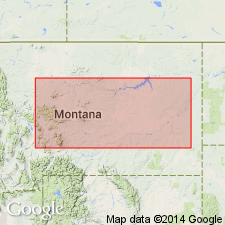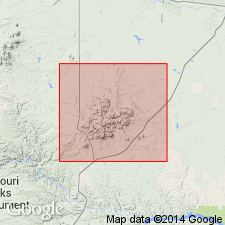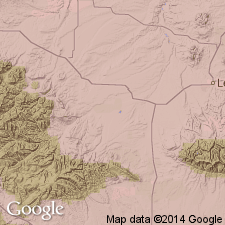
- Usage in publication:
-
- Little Chief Canyon member*
- Modifications:
-
- Named
- Biostratigraphic dating
- AAPG geologic province:
-
- Williston basin
- Central Montana uplift
- Montana folded belt
Summary:
Name proposed for the basal member of Lodgepole limestone. At type locality consists of about 1.5 feet of black conodont-bearing shale. Sharp contact with overlying Lodgepole and underlying Jefferson formation. Formerly treated as lowermost unit of Lodgepole (citing Knechtel and Huss, 1938; Cooper and Sloss, 1943). Correlated with thin black basal shale of Lodgepole in: (1) Rock Creek Canyon, in sec. 8, T. 12 N., R. 18 E., Fergus County, Montana; (2) on north bank of Gallatin River opposite Logan, in S/2 sec. 25, T. 2 N., R. 2 E., Gallatin County, Montana; and (3) on Cedar Creek anticline, from depth of 8,505 feet in Shell Oil Company's Pine Unit No. 1 Well, in sec. 30, T. 12 N., R. 57 E., Wibaux County, Montana, Williston basin. Available information relating to wells drilled near margin of Williston basin, northeastern Montana, suggests member corresponds with only upper black shale unit of subsurface Bakken formation. Uncertainty regarding its relation to the three Bakken units and to comparable lithologic units in adjacent parts of Canada. Established Little Chief Canyon Member is preferred as basal member of Lodgepole. Age is Early Mississippian (Kinderhook), based on fossils (conodont fauna).
Typically exposed [type locality] in Little Chief Canyon of Lodgepole Creek, about 3 1/2 mi south-southwest of Lodgepole Subagency of Fort Belknap Indian Reservation, in N/2 sec. 27, T. 26 N., R. 25 E., Blaine Co., MT, Williston basin. [Geologic map (Knechtel 1959) shows outcrop in Little Chief Canyon in sec. 30, rather than sec. 27].
Source: Modified from GNU records (USGS DDS-6; Denver GNULEX).

- Usage in publication:
-
- Little Chief Canyon member*
- Modifications:
-
- Revised
- AAPG geologic province:
-
- Williston basin
Summary:
Member of Lodgepole limestone. Underlain by Three Forks? shale in the Little Rocky Mountains, Blaine and Phillips Cos, MT in the Williston basin. Early Mississippian in age.
Source: GNU records (USGS DDS-6; Denver GNULEX).

- Usage in publication:
-
- Little Chief Canyon Member*†
- Modifications:
-
- Abandoned
Summary:
Name abandoned for a member of the Lodgepole Limestone. An analysis of Devonian and Mississippian shale units in the northern Cordillera by Sandberg and Mapel (1967) has shown that shale in Little Chief Canyon, Blaine Co, MT in the Williston basin, is the upper black shale of the Bakken Formation, and that the shale at Logan, MT, in the Montana folded belt province, belongs in the Cottonwood Canyon Member of the Lodgepole Limestone. Such usage obviates the necessity for the term Little Chief Canyon Member.
Source: GNU records (USGS DDS-6; Denver GNULEX).
For more information, please contact Nancy Stamm, Geologic Names Committee Secretary.
Asterisk (*) indicates published by U.S. Geological Survey authors.
"No current usage" (†) implies that a name has been abandoned or has fallen into disuse. Former usage and, if known, replacement name given in parentheses ( ).
Slash (/) indicates name conflicts with nomenclatural guidelines (CSN, 1933; ACSN, 1961, 1970; NACSN, 1983, 2005, 2021). May be explained within brackets ([ ]).

